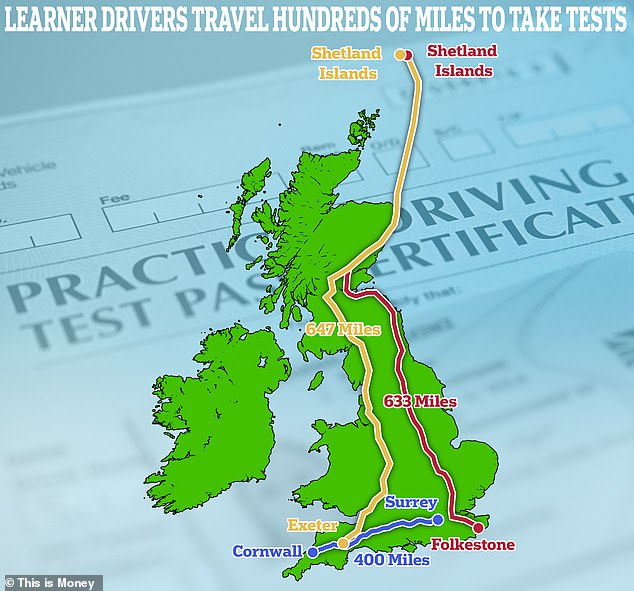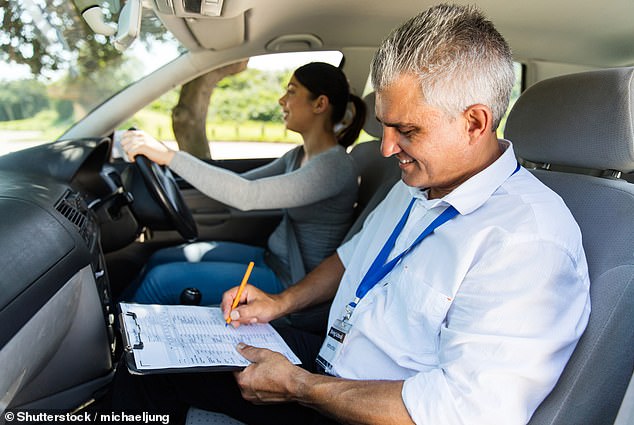‘I travelled 400 miles to take my driving test’: How learners are having to travel across the UK to clear test centre backlogs
New research shows that learners are travelling almost twice as far to take their driving test than they did before the Covid-19 pandemic. What’s more, huge delays in available test slots are leaving novice drivers at an endless disadvantage.
With the Driver and Vehicle Standard Agency (DVSA) failing to address the huge backlog of learners, novice drivers are having to take action themselves to secure a place on a practical test as soon as possible.
The investigation found that one young driver had to travel as much as 640 kilometres to avoid having to wait months for a booking in his hometown.
After an in-depth analysis of more than six million driving test records, Marmalade found that learners would have to travel an average of up to 25 miles (24.49) for a test by 2030 – a 194% increase on 2019
Multiple disclosure requests by Marmalade car insurance to the DVSA over a six-month period revealed that learners would have to travel 48 per cent further to take their driving test in 2023 compared to 2019.
The average distance traveled from their home to a testing center rose to 19.86 kilometers in the most recent full year – 2023 – compared to 13.46 kilometers in 2019.
And it doesn’t look like it will get any better anytime soon.
After an in-depth analysis of more than six million driving test data, Marmalade found that by 2030, students would have to travel an average of 40 kilometers (39.4 miles) for a test – a 194 percent increase from 2019.
This represents an increase of 10.3 percent per year.
Mark Steeples, driving instructor at Pass Mark School of Driving, said it was “pretty astonishing” that learners will soon have to travel an average of 25 miles to sit a test.
‘I am amazed at the annual increase in the distance that has to be covered for a driving test, but I think it shows how desperate people are to learn to drive and that they will do anything to achieve that.’
North-South divide for driving test availability
The data also shows that a geographical divide has emerged, with pupils in the south of England having to drive significantly further for a test than those in the north.
In 2023, students in the Southeast traveled farther than anyone else, 13.9 miles. While students in the Northwest traveled an average of 7.1 miles — nearly half the distance.
Unsurprisingly, London has seen the largest increase in distance learning students being forced to travel to take a test: 7.7 miles in 2019, rising to a whopping 17.7 miles in 2023.
That’s a whopping 130.77 percent increase, with an average growth rate of 23.25 percent per year.
A similar growth pattern is seen in the Southeast and East, which reported annual growth rates of 21.2 percent and 12.95 percent respectively.
Students in these three regions are finding it increasingly difficult to obtain a driver’s license after spending hours of hard work preparing for their practical exam.
In total, 164 test centres in the UK saw a greater than average distance travelled in 2023, as the localisation of test centres and the availability of testing spaces decreased.
Approximately 34,614 students traveled more than 100 miles.
Mark says he has received inquiries from people who are willing to travel further afield for a test.
‘I have had enquiries from people wanting to learn and take a test about 50 miles away from me. Why would you go to an area you don’t know? It’s hard enough taking a test anyway, you have a lifetime to drive on British roads, but don’t choose the day of your driving test to do it.
‘Many instructors only teach on test routes in the region, but that means most students are unprepared for any test route and the potential consequences of driving in an unfamiliar place.’
I drove 400 miles to pass my driving test

Kayla Van Dorsten drove all the way from Surrey to Cornwall to get her driving license
Kayla Van Dorsten, a student, found it so difficult to find an available spot for a practical exam near where she lived that she had to travel 400 miles to overcome a six-month waiting list at her local centers.
The 18-year-old drove all the way from Surrey to Cornwall to get her driving licence, as she needed to be able to drive herself to university.
“I was already nervous about my driving test, but being in an unfamiliar area meant I had to overcome new obstacles,” she explains.
‘There were different speed limits than on the local routes I had practiced on. There were also other road users I didn’t know, such as tractors.
‘Because I had to take the test four hours in advance, I had to take two days off from my studies and pay for accommodation and petrol to get to the test centre. It was very inconvenient, but I had to get my driver’s license as soon as possible, because due to strikes I could no longer rely on public transport to get to university.’
And Kayla isn’t the only one…
In 2023, one apprentice travelled a whopping 650 miles from Exeter to Shetland to take his practical test, while another travelled 630 miles from Folkestone to Shetland.


Lerwick DVSA centre, Shetland. In 2023, one apprentice travelled a whopping 647 miles from Exter to Shetland to take his practical test, while another travelled 633 miles from Folkestone to Shetland
Shetland is a country with a considerable long-distance character: 10 of the 20 fastest distances covered end on the Scottish island.
On the other hand, some students only had to take to the streets to sit their test. Drivers travelling to the Heckmondwike test centre in Kirklees, West Yorkshire, had the shortest journey in the UK, with an average distance of 3.8 miles.
Why are the waiting times at test centers so long?
In March, three quarters of driving test centres had an average waiting time of more than six weeks.
According to This is Money, at the end of January, 245 testing centres still had waiting times of more than a month, higher than before the pandemic.
In addition, following a FOI request to the Driving Standards Agency (DVSA), the AA Driving School found that almost two-fifths of test centres had waiting times of more than five months.
Camilla Benitz, chief executive of AA Driving School, said at the time: “It is unacceptable that we are now almost two years into the pandemic restrictions and that novice drivers and instructors are still suffering the consequences.”
The ongoing delays since testing centers were forced to close their doors in 2020 due to COVID have been attributed to a ‘post-pandemic slowdown’.
Still going through In the summer of 2022, more than half a million people were still waiting for a test – an increase from the pandemic-related backlog in 2021, when it was just under 500,000.
In early 2023, parliament was told that enrolment levels should return to pre-pandemic levels within a few months, and all eligible DVSA staff were asked to resume full-time driving tests.
But despite the DVSA’s measures to increase testing capacity, average waiting times increased or remained the same at 45 per cent of testing centres.
Between 2 October 2023, when the DVSA began adding more test slots to help clear the backlog, and 29 January 2024, waiting times worsened at 15 per cent of all test centres. They remained the same at 25 per cent and improved to 60 per cent.
Does test delay have a negative effect on the pass rate?

Between March 2023 and 2024, the UK saw the lowest number of theory and practical tests taken and passed since 2021
Cap Hpi, a provider of automotive background checks, found a correlation between longer test wait times and lower pass rates.
Looking at the DVSA statistics, we see that between 2023 and 2024, 1,384,678 practical tests were taken and 668,038 passed. That is a pass rate of 48 percent.
For comparison: in the period 2021-2022, 751,914 students passed the driving test out of 1,528,314 practical exams. That is a pass rate of 49 percent.
Between March 2023 and 2024, the UK saw the lowest number of theory and practical exams taken and passed since 2021.
In 2022, Jenna Williams, a driving instructor from Cardiff, told the BBC that waiting times are a reason for failing driving tests: ‘I think the reason why learners feel so much pressure is because of the long waiting lists for a new test. As you said, if they fail, they have five or six months, and another five months to go.’
Some links in this article may be affiliate links. If you click on them, we may earn a small commission. That helps us fund This Is Money and keep it free. We do not write articles to promote products. We do not allow commercial relationships to influence our editorial independence.
